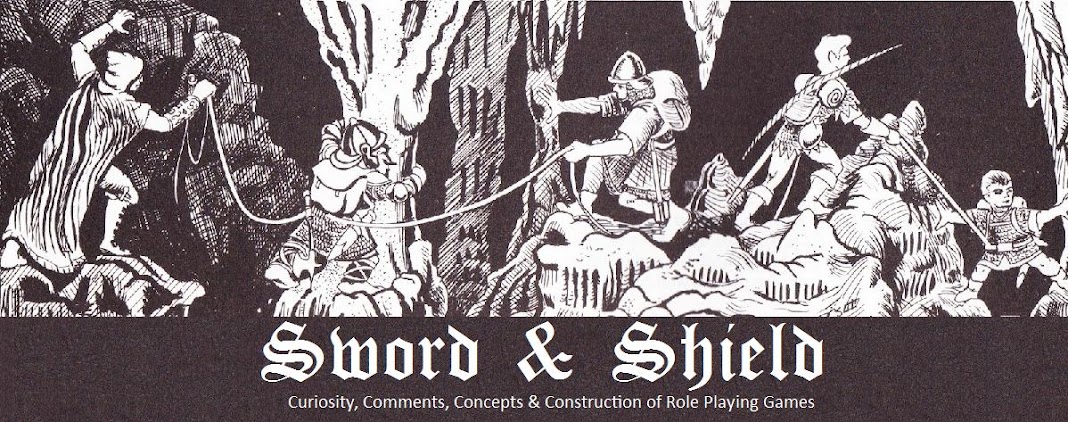This option would allow for the players modified attack roll difference (vs target number) to imply mechanically a deadlier blow was delivered.
How it Works
You roll to hit as normal. If a successful strike was delivered, subtract the target number from the players modified die roll total. This result is then compared to the chart below :
Damage table
- Difference of 1 to 3 = 2pts damage
- Difference of 4 to 6 = 4pts damage
- Difference of 7 to 9 = 6pts damage
- Difference of 10 or more = 6pts+1d6 damage
- If a two handed weapon is used in combat add +2 to the damage done
Damage effects
You may wish to add a bit of flair or impact to combat. To do so (for roughly man sized opponents)see the options below:
- IF DAMAGE RESULT IS 4 POINTS roll an additional 1d6. If the result is an even number there is no additional effect, if the roll is an odd number the target staggers back a distance in feet equal to number on die roll.
- IF DAMAGE RESULT IS 6 POINTS roll an additional 1d6. If the result is an even number the target staggers back a distance in feet equal to the number rolled. If the result is an odd number, the target falls to the ground and must spend their next action standing up.
- IF DAMAGE RESULT is 6+1d6 use the total sum of damage. If the result is an even number the target is knocked down and must spend their next action standing up. If the result is an odd number, the target is knocked down and stunned and may make no action on their next turn. The next action the target makes is either to stand or flee.
Mechanical Example: The player attacks a target wearing leather armor (AC12) The player rolls a d20 and gets a result of 16. The difference between the target number (12) and the die roll (16) is 4. Using the damage chart it shows 4 points of damage are applied to the target. Using the optional rules the player would roll another d6 to see if there was knock back. The player rolls and gets a result of 3, so the target would stagger back 3 feet after taking the damage
Cinematic version: Toshiro Redcap spies an archer guarding a passage way up ahead. Clinging to shadows cast by flickering torchlight he creeps to within striking distance. Edging closer his final step suddenly sends a sharp squeak into the silence. The nightingale board gives away Toshiro’s movement and the archer spins round on him drawing back his bow. The archer turns too late as Toshiro’s katana slashes down cleaving the gap between them and biting through the archer’s armor. Blood wells from the cut and the archer staggers back in pain and surprise.
I think mechanically it works and fits with the cinematic combat of earlier editions. Jim at Carjacked Seraphim posted a simple to use chart for this mechanic to use with OD&D and/or other d20 systems. Kudos Jim! I can't wait to use your chart for my Halloween haunted house game.


9 comments:
I like this A LOT. Thanks for sharing. I may try to work on a table where the attacker rolls d20 and d6; comparing the results of each to an AC table. This would give the damage and any secondary effects with one roll and table lookup. :) Wonderful ideas...
Thanks Jim!
I had some thoughtful posts on my last d6 damage table for my Roguish RPG. I thought about it over the week and came up with this instead. Works well for classic D&D and with my homebrew game too. I look forward to seeing your table, please let me know when it is up!
It's up at my blog. :) http://carjackedseraphim.blogspot.com/2010/10/attack-and-damage-rolls.html
Wow, Jim that looks great! I will add a link to your post at the end of mine!
Interesting concept. Unfortunately it makes the hard to hit monsters even tougher. I have also found that subtituting math for dice rolls, does not speed play up. I am not saying don't use it, but just be aware of the drawbacks if you do. Took a peek at Jim's chart as well, I think if you are using this system having a chart available is a good idea as well. Althouh your extra effects are cool, I am not sure I like adding the extra effects to the higher damage. By combining them you insure that when the monsters dice are hot you're really in deep kimchee.
@imredave-Many interesting points and it will take more testing to determine how well it works long term. The extra effects from damage are stated as optional, so no reason to use them if you do not want to. I included them here as an option as some people like extra effects in combat that stem from an opponent taking damage.
I will have to think about larger monsters and handling them in this system.
since the secondary effect check is just an odd/even roll, why not just go by whether the original to-hit roll was odd or even? that way you get all the information with a single die roll
@frijoles JR.: that is a great idea! Simple and EASY! Gracias amigo!
I think you could call this combat system "Rolemaster."
Post a Comment